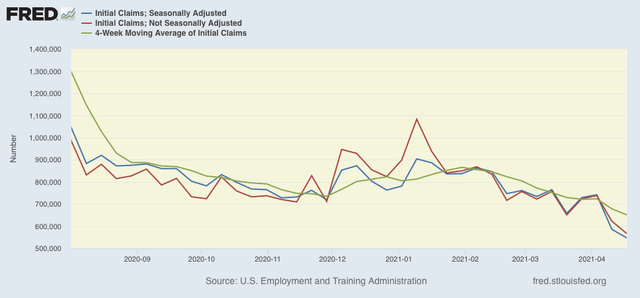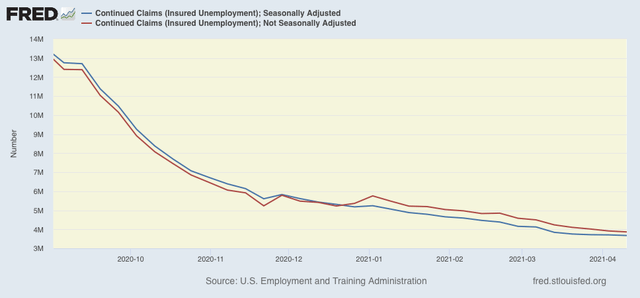More new pandemic lows in jobless claims: April jobs report likely to show over 1,000,000 new jobs added Repeating my recent top-line mantra, new jobless claims are likely to the most important weekly economic data for the next 3 to 6 months. With the number of those vaccinated continuing to increase, I expect an ongoing big increase in renewed consumer and social activities, with a concomitant gain in monthly employment gains like we saw in the March jobs report.Five weeks ago I set a few objective targets: new claims to be under 500,000 by Memorial Day, and below 400,000 by Labor Day. This week we continued our major advance towards those targets.On an unadjusted basis, new jobless claims declined by 56,554 to 566,479. Seasonally adjusted
Topics:
NewDealdemocrat considers the following as important: jobless claims, US EConomics, US/Global Economics
This could be interesting, too:
NewDealdemocrat writes JOLTS revisions from Yesterday’s Report
Bill Haskell writes The North American Automobile Industry Waits for Trump and the Gov. to Act
Bill Haskell writes Families Struggle Paying for Child Care While Working
Joel Eissenberg writes Time for Senate Dems to stand up against Trump/Musk
More new pandemic lows in jobless claims: April jobs report likely to show over 1,000,000 new jobs added
Repeating my recent top-line mantra, new jobless claims are likely to the most important weekly economic data for the next 3 to 6 months. With the number of those vaccinated continuing to increase, I expect an ongoing big increase in renewed consumer and social activities, with a concomitant gain in monthly employment gains like we saw in the March jobs report.Five weeks ago I set a few objective targets: new claims to be under 500,000 by Memorial Day, and below 400,000 by Labor Day.
This week we continued our major advance towards those targets.
On an unadjusted basis, new jobless claims declined by 56,554 to 566,479. Seasonally adjusted claims declined by 39,000 to 547,000. The 4 week average of claims also declined by 27,750 to 651,000.
At their worst one year ago, initial claims were in the range of 5 to 7 million per week! Here’s how the trend looks since last last August:

One note of perspective: during the Great Recession, even at their *worst* level, new initial claims were 665,000.
Continuing claims, which are reported with a one week lag, and lag the trend of intitial claims typically by a few weeks to several months, also declined to new pandemic lows on both an adjusted and unadjusted basis. The unadjusted number declined 50,774 to 3,862,890, while after seasonal adjustment the decline was 34,000 to 3,674,000:

Seasonally adjusted continued claims are at levels last seen in late 2011 when weekly jobless claims were just under 400,000 and the unemployment rate was 8.5%.
In the last 5 weeks, since the March reference week for the jobs report, initial claims have declined on average by almost 100,000 m/m. This kind of decline only happened three times since data started to be collected almost 60 years ago until the pandemic, and was associated with strong monthly employment gains on the order of +350,000. Last year, when we had a similar decline in July, we gained 1,726,000 jobs.
As a result, I now expect April’s jobs report to show a gain of well over 1,000,000 jobs, and possibly closer to 2,000,000. Additionally, my concern that new and more infectious variants of COVID might undercut progress with vaccinations is fading as the data has shown a plateau and even a slight renewed decline in new cases.
